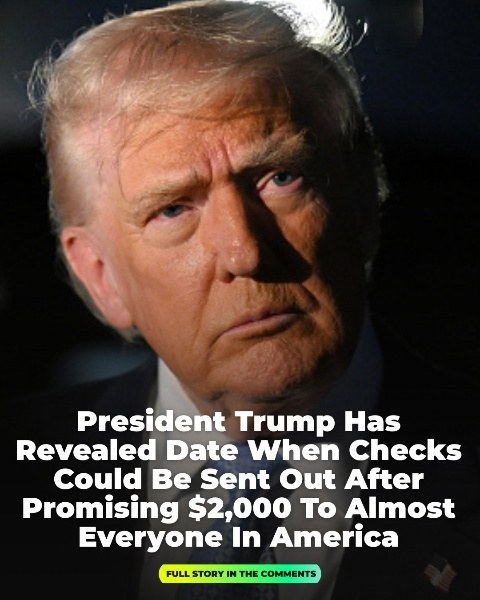The promise landed with the force of a campaign-trail thunderclap, packaged in the kind of simplicity that always makes people pause: a $2,000 dividend for every working family, paid straight from the revenue of aggressive new tariffs. The idea sounded clean, sharp, and almost elegant—money flowing back to the people, a closed loop where America taxed foreign goods and handed the spoils to its own citizens. At least, that was the pitch.
But beneath the applause lines and viral clips, the reality was already buckling under its own weight.
In the weeks following the announcement, analysts across the political spectrum did the math publicly, loudly, and with increasingly sharp tones. Tariffs had generated money, yes, but nowhere near enough to sustain the sweeping promise being televised across the country. Billions had come in—less than half of what the proposal needed—but most of that revenue was already locked in legal disputes, frozen behind injunctions and tied up in a bureaucratic maze that even seasoned policymakers struggled to explain.
And the courts were circling.
The Supreme Court had agreed to hear a challenge to the administration’s use of emergency powers to impose the tariffs in the first place. The courtroom buzzed with tension as the justices pressed the government’s lawyers on how far executive authority could stretch before it snapped. Observers could see the writing on the wall: skepticism ran deep, and a ruling against the administration would not only strip the proposal of its foundation but could also trigger a legal domino effect—including possible refunds to corporations, importers, and trade groups that had been fighting the tariffs for months.
The political stakes were enormous. The economic stakes were bigger.
Still, the White House hammered the message: the money was coming. Soon. Very soon.
But behind closed doors, even the administration’s allies admitted that no one had a timeline—not for the rollout, not for the eligibility rules, not for the mechanism of the payment itself. Would it be mailed checks? Digital disbursements? Tax credits? A rebate on future filings? No one could say. Congress hadn’t passed anything concrete, and negotiations had stalled in a fog of competing priorities.
Some lawmakers called it bold. Others called it reckless. Most, however, said it was classic election-year theater: a headline dressed as a policy.
Americans, meanwhile, reacted the way they often do in moments like this—split between cautious hope and seasoned cynicism. Families struggling with rent, medical bills, and groceries treated the idea of a $2,000 check like a warm breeze blowing in their direction. They didn’t trust it, not fully, but they felt the pull of what it could mean. A few weeks of breathing room. A repaired car. A month without choosing between bills. Even skeptics found themselves imagining the “what if.”
But as the days rolled on, the optimism thinned. Reporters kept asking the same question: When should Americans expect the payout?
Every answer from officials seemed to blur into the same fog: “Working on it… reviewing options… finalizing details… awaiting legislative cooperation.”
Behind the curtain, congressional aides whispered about the real issue: there simply wasn’t agreement on who would qualify. Income caps? Household size? Citizenship status? Phase-outs? Would the payment be universal or targeted? Every proposal met resistance before the ink was dry.
And then there was the politics.
Hardliners wanted strict limits. Moderates wanted broad access. Governors demanded assurances that states wouldn’t get saddled with administrative costs. Policy wonks worried about inflation. Economists worried about market reaction. And fiscal conservatives warned that relying on tariff revenue—a notoriously unstable source of income—was a house built on shifting sand.
Still, the administration refused to back down. At one point, the President doubled down on camera, insisting that “high earners won’t get a dime” and that if the courts blocked the tariff mechanism, “we’ll do something else—trust me.”
It was the “something else” that raised eyebrows. No one in Congress knew what it meant. No one in the Treasury Department, either, according to a leaked memo circulating quietly through Washington.
Meanwhile, the people waited.
In diners, barbershops, grocery store aisles, and endless social media threads, the same conversation kept looping: Is this real? Is the money actually coming? Or is this just another promise meant to fade after the election cycle?
For many Americans, the answer didn’t matter as much as the feeling. The story had cracked open a familiar wound—one shaped by years of political pledges that never made it into the real world. Stimulus talk, tax talks, rebates, credits, relief programs—people had seen the cycle enough times to spot the pattern. Excitement. Confusion. Delay. Disappointment. Repeat.
And yet, hope clung to the corners of the narrative, stubborn as ever. Because in a country where millions live close enough to the financial edge to feel the breeze when it shifts, even the rumor of relief becomes a kind of temporary comfort.
But as hearings continued, court challenges grew louder, and congressional negotiations moved at a crawl, the truth became impossible to ignore: there was no timeline, no distribution plan, no clarity.
Just a promise floating in political air.
A familiar promise. One with weight but no shape.
And so, as the final briefings of the month concluded, the only honest answer left standing was the one no official wanted to say aloud: Americans shouldn’t expect the payout anytime soon. Not next week. Not next month. Maybe not at all.
For now, the idea remained exactly what it had always been—a headline dressed as certainty, drifting through the national conversation, offering hope that couldn’t yet be cashed.
